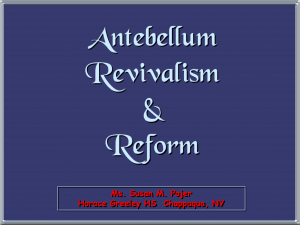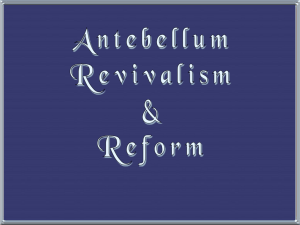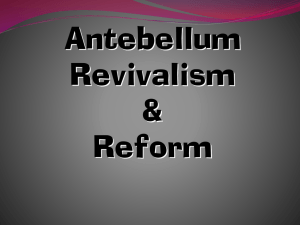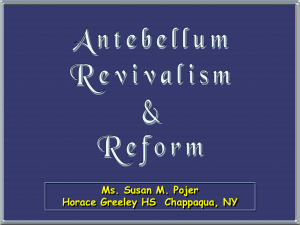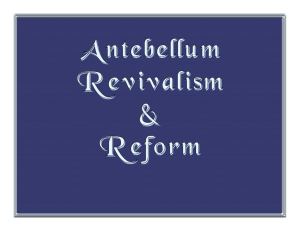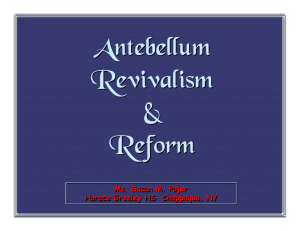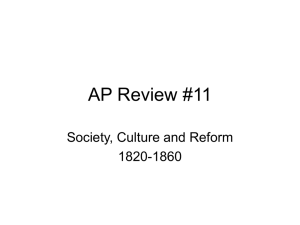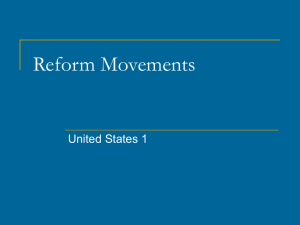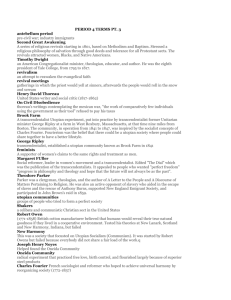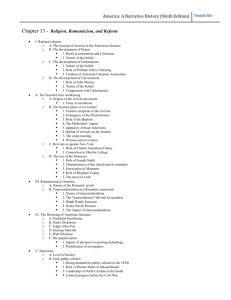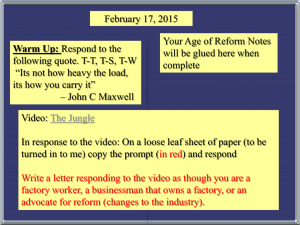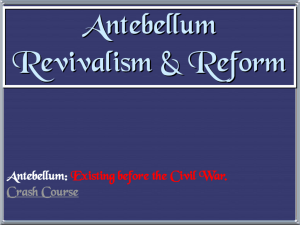Antebellum Reform Movements
advertisement
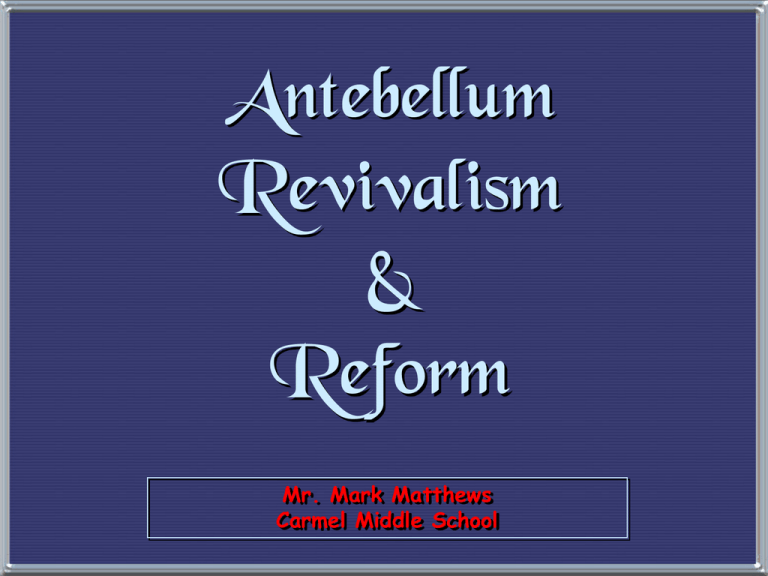
Antebellum Revivalism & Reform Mr. Mark Matthews Carmel Middle School “T he Pursuit of Perfection” In Antebellum America T he Second Great Awakening “Spiritual Reform From Within” [Religious Revivalism] Social Reforms & Redefining the Ideal of Equality Temperance Education Abolitionism Asylum & Penal Reform Women’s Rights 1. Transcendentalism (European Romanticism) e Liberation from understanding and the cultivation of reasoning.” e “Transcend” the limits of intellect and allow the emotions, the SOUL, to create an original relationship with the Universe. Transcendentalist T hinking Man must acknowledge a body of moral truths that were intuitive and must TRANSCEND more sensational proof: 1. The infinite benevolence of God. 2. The infinite benevolence of nature. 3. The divinity of man. They instinctively rejected all secular authority and the authority of organized churches and the Scriptures, of law, or of conventions Transcendentalism (European Romanticism) Therefore, if man was divine, it would be wicked that he should be held in slavery, or his soul corrupted by superstition, or his mind clouded by ignorance!! Thus, the role of the reformer was to restore man to that divinity which God had endowed them. Transcendentalist Intellectuals/Writers Concord, M A Ralph Waldo Emerson Nature (1832) Self-Reliance (1841) Henry David Thoreau Walden (1854) Resistance to Civil Disobedience (1849) R3-1/3/4/5 T he Transcendentalist A genda Give freedom to the slave. Give well-being to the poor and the miserable. Give learning to the ignorant. Give health to the sick. Give peace and justice to society. A Transcendentalist Critic: Nathaniel Hawthorne (1804-1864) e Their pursuit of the ideal led to a distorted view of human nature and possibilities: * The Blithedale Romance e One should accept the world as an imperfect place: * Scarlet Letter * House of the Seven Gables Second Great Awakening Revival Meeting Charles G. Finney (1792 – 1895) “soul-shaking” conversion R1-2 The ranges of tents, the fires, reflecting light…; the candles and lamps illuminating the encampment; hundreds moving to and fro…;the preaching, praying, singing, and shouting,… like the sound of many waters, was enough to swallow up all the powers of contemplation. T he Mormons (The Church of Jesus Christ of Latter-Day Saints) 1823 Golden Tablets 1830 Book of Mormon 1844 Murdered in Carthage, IL Joseph Smith (1805-1844) T he Mormon “Trek” T he Mormons (The Church of Jesus Christ of Latter-Day Saints) Deseret community. Salt Lake City, Utah Brigham Young (1801-1877) Mother Ann Lee (1736-1784) T he Shakers e If you will take up your crosses against the works of generations, and follow Christ in the regeneration, God will cleanse you from all unrighteousness. e Remember the cries of those who are in need and trouble, that when you are in trouble, God may hear your cries. e If you improve in one talent, God will give you more. R1-4 Shaker Meeting Shaker Hymn Or March? 'Tis the gift to be simple, 'Tis the gift to be free, 'Tis the gift to come down where you ought to be, And when we find ourselves in the place just right, 'Twill be in the valley of love and delight. When true simplicity is gained To bow and to bend we will not be ashamed, To turn, turn will be our delight, 'Till by turning, turning we come round right. Shaker Simplicity & Utility 3. Utopian Communities Secular Utopian Communities Individual Freedom Demands of Community Life e spontaneity e discipline e self-fulfillment e organizational hierarchy Robert Owen (1771-1858) Utopian Socialist “Village of Cooperation” Original Plans for New Harmony, IN New Harmony in 1832 New Harmony, IN Penitentiary Reform Dorothea Dix (1802-1887) 1821 first penitentiary founded in Auburn, NY Dorothea Dix Asylum - 1849 Temperance Movement 1826 - American Temperance Society “Demon Rum”! Frances Willard The Beecher Family “T he Drunkard’s Progress” From the first glass to the grave, 1846 Educational Reform Religious Training Secular Education e MA e By always on the forefront of public educational reform * 1st state to establish tax support for local public schools. 1860 every state offered free public education to whites. * US had one of the highest literacy rates. Horace Mann (1796-1859) “Father of American Education” e children were clay in the hands of teachers and school officials e children should be “molded” into a state of perfection e discouraged corporal punishment e established state teachertraining programs T he McGuffey Eclectic Readers e Used religious parables to teach “American values.” e Teach middle class morality and respect for order. e Teach “3 Rs” + “Protestant ethic” (frugality, hard work, sobriety) Women Educators e Troy, NY Female Seminary e curriculum: math, physics, history, geography. e train female teachers Emma Willard (1787-1870) e 1837 she established Mt. Holyoke [So. Hadley, MA] as the first college for women. Mary Lyons (1797-1849) Early 19c Women 1. Unable to vote. 2. Legal status of a minor. 3. Single could own her own property. 4. Married no control over her property or her children. 5. Could not initiate divorce. 6. Couldn’t make wills, sign a contract, or bring suit in court without her husband’s permission. R2-6/7 Women’s Rights 1840 split in the abolitionist movement over women’s role in it. London World Anti-Slavery Convention Lucretia Mott Elizabeth Cady Stanton 1848 Seneca Falls Declaration of Sentiments Seneca Falls Declaration Cult of Domesticity = Slavery The 2nd Great Awakening inspired women to improve society. Angelina Grimké Sarah Grimké e Southern Abolitionists R2-9 Lucy Stone e American Women’s Suffrage Assoc. e edited Woman’s Journal 7. Abolitionist Movement e 1816 American Colonization Society created (gradual, voluntary emancipation. British Colonization Society symbol Abolitionist Movement e Create a free slave state in Liberia, West Africa. e No real anti-slavery sentiment in the North in the 1820s & 1830s. Gradualists Immediatists Anti-Slavery Alphabet W illiam Lloyd Garrison (1801-1879) e Slavery undermined republican values. e Immediate emancipation with NO compensation. e Slavery was a moral, not an economic issue. R2-4 T he Liberator Premiere issue January 1, 1831 R2-5 T he Tree of Slavery—Loaded with the Sum of All Villanies! 8. “Separate Spheres” Concept “Cult of Domesticity” e A woman’s “sphere” was in the home (it was a refuge from the cruel world outside). e Her role was to “civilize” her husband and family. e An 1830s MA minister: The power of woman is her dependence. A woman who gives up that dependence on man to become a reformer yields the power God has given her for her protection, and her character becomes unnatural! Black Abolitionists David Walker (1785-1830) 1829 Appeal to the Coloured Citizens of the World Fight for freedom rather than wait to be set free by whites. Frederick Douglass (1817-1895) 1845 The Narrative of the Life Of Frederick Douglass 1847 “The North Star” R2-12 Sojourner Truth (1787-1883) or Isabella Baumfree 1850 The Narrative of Sojourner Truth R2-10 Harriet Tubman (1820-1913) e Helped over 300 slaves to freedom. e $40,000 bounty on her head. e Served as a Union spy during the Civil War. “Moses” Leading Escaping Slaves Along the Underground Railroad T he Underground Railroad T he Underground Railroad e “Conductor” ==== leader of the escape e “Passengers” ==== escaping slaves e “Tracks” ==== routes e “Trains” ==== farm wagons transporting the escaping slaves e “Depots” ==== safe houses to rest/sleep
